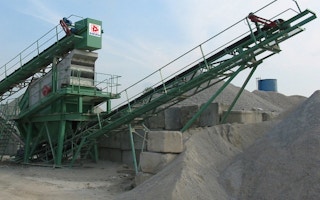Construction suppliers have had to get creative to meet Singapore’s relentless demand for new, greener building materials. Through research and development efforts and cooperation with the Republic’s building authority, concrete manufacturers have come up with new ways of using Singapore’s waste streams to reduce the need for virgin raw materials.
In this follow-up to a previous article on how the construction industry is making a dent in Singapore’s waste volumes through recycling, Eco-Business spoke to Koh Hoon Kiat, marketing officer at local building supply manufacturer Samwoh.
Eco-Business: In 2010, the Samwoh Eco-Green Building became the first building in Singapore to use 100 per cent recycled ingredients for its concrete aggregate (the material added to cement and water to make the final concrete product). Since its completion, have other projects used completely recycled concrete aggregate (RCA)?
KHK: Nope. Current building standards only allow up to 20 per cent to be used. The Samwoh Eco-Green Building is an exception because it was a joint research project with BCA (Building and Construction Authority) and NTU (Nanyang Technological University). It was the successful completion of this research that convinced BCA to allow the use of up to 20 per cent RCA in other building projects.
EB: The volumes of the types of waste that are approved for recycling into concrete are much lower than demand for material. Is this creating competition between construction supply companies for waste?
KHK: It would not be accurate to say that companies are competing for waste material. If that were true, the waste material would cost more than virgin material. However, it is true that the amount of waste produced annually is not able to meet the demand for aggregate in the construction industry.
EB: So how does Samwoh ensure the future supply of materials for recycling?
KHK: We have to make use of the available recycled materials efficiently and to plan our production with due diligence. One other thing that we do is to constantly carry out R&D to explore potential waste streams and their applications.
EB: Are there many potential waste streams out there that are as yet untapped?
KHK: Definitely, there are still some potential waste streams in the market for us to explore. For example, scrap tyre rubber, glass, treated sludge, incinerated bottom ash from refuse waste etc.
EB: Apart from the recycling of construction and demolition waste for concrete production, what are some of Samwoh’s other eco-friendly concrete initiatives?
We have undertaken several green initiatives on concrete production. These include:
- Recycling of returned fresh concrete via a concrete reclaimer whereby the fresh concrete is being washed (with recycled water) to extract aggregate for reuse.
- Use of green cement, such as ground granulated blast furnace slag (GGBS), as one of the ingredients for our green concrete. The carbon footprint of GGBS is much lower than that of conventional cement.
- Study of carbon footprint of recycled concrete aggregate (RCA) compared to natural aggregate. Our study has found that RCA produces less carbon dioxide than granite, which is imported from overseas (Singapore imports granite as we don’t have our own supply).
- Our concrete mixer trucks are constantly being upgraded to greener models, and last year, we carried out a joint study with the Land Transport Authority as well as a tertiary institution to tackle the common problem of concrete dripping from mixer trucks.
- Last but not least, we have implemented the Global Positioning System (GPS) to plot the best routes for our concrete mixer trucks. This helps boost productivity by providing timely delivery, and it reduces fuel consumption.
EB: Samwoh’s activities cover road-building materials as well. Could you expand on Samwoh’s asphalt recycling?
KHK: Our asphalt operation has various green initiatives as well – we have two production plants that can recycle waste asphalt into fresh asphalt. This allows us to actually recycle bitumen (a by-product from petroleum industry) and granite aggregates. Also, our new plant, which was completed in July 2012, greatly reduces the energy consumption of asphalt production because it runs at a production temperature that is about 20 degrees Celsius lower than other plants.
Samwoh is one of the private corporations that has partnered with the National Environment Agency to reach Singapore’s ‘Towards zero waste’ goal. Read more about the NEA’s approach here.










